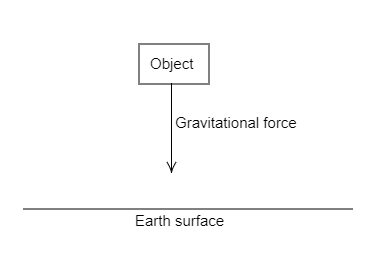
The gravitational unit of force in the metric system is:
(A) $g\,wt$
(B) $N$
(C) $kg\,wt$
(D) none of these
Answer
534.3k+ views
Hint: The gravitational force is said to be directly proportional to the mass of the objects interacting, objects with more mass will attract each other with a greater gravitational force. When the mass of either object increases, then the force of gravitational attraction between the masses also increases.
Complete step by step answer:
The gravitational force between a mass of the object and the Earth is the object’s weight. Mass is a measure of an object’s inertia, and its weight is the force that exerts on the object in a gravitational field. On the surface of the Earth, the two forces can be related by the acceleration due to gravity, $Fg = mg$. The Kilograms and slugs are the units of mass; The Newton’s and pounds are the units of weight.
The absolute units of force will not depend upon the value of acceleration due to gravity, so they will remain the same as throughout the universe. But the gravitational unit of force will depend upon the value of $g$ which will be different at different places. The weight is taken to mean the same as mass and is measured in kilograms. However, Scientifically, it is normal to state that the weight of a body is the gravitational force acting on it.

The weight of an object is given as, $W = mg$
Where,
$m$ is the mass of the body
$g$ the acceleration due to gravity of the body
By considering mass of the object as $1\,kg$
$W = 1\,kg \times 9.8\,m{s^{ - 2}}$
$W = 9.8\,N$ (For $1\,kg$ of weight)
Kilogram weight is a measure of weight (gravitational pull).
Thus, the gravitational unit of force in the metric system is $kg\,wt$. Hence option (C) is correct.
Note:
By using Newton’s law of gravitation we can get the acceleration due to gravity $g$, on the surface of the Earth by knowing the gravitational constant $G$, the mass of the Earth, and the radius of the Earth. Newton’s law of gravitation gives the acceleration due to gravity near the surface of the Earth as $9.8\,m{s^{ - 2}}$.
Complete step by step answer:
The gravitational force between a mass of the object and the Earth is the object’s weight. Mass is a measure of an object’s inertia, and its weight is the force that exerts on the object in a gravitational field. On the surface of the Earth, the two forces can be related by the acceleration due to gravity, $Fg = mg$. The Kilograms and slugs are the units of mass; The Newton’s and pounds are the units of weight.
The absolute units of force will not depend upon the value of acceleration due to gravity, so they will remain the same as throughout the universe. But the gravitational unit of force will depend upon the value of $g$ which will be different at different places. The weight is taken to mean the same as mass and is measured in kilograms. However, Scientifically, it is normal to state that the weight of a body is the gravitational force acting on it.

The weight of an object is given as, $W = mg$
Where,
$m$ is the mass of the body
$g$ the acceleration due to gravity of the body
By considering mass of the object as $1\,kg$
$W = 1\,kg \times 9.8\,m{s^{ - 2}}$
$W = 9.8\,N$ (For $1\,kg$ of weight)
Kilogram weight is a measure of weight (gravitational pull).
Thus, the gravitational unit of force in the metric system is $kg\,wt$. Hence option (C) is correct.
Note:
By using Newton’s law of gravitation we can get the acceleration due to gravity $g$, on the surface of the Earth by knowing the gravitational constant $G$, the mass of the Earth, and the radius of the Earth. Newton’s law of gravitation gives the acceleration due to gravity near the surface of the Earth as $9.8\,m{s^{ - 2}}$.
Recently Updated Pages
Class 11 Question and Answer - Your Ultimate Solutions Guide

Master Class 11 Accountancy: Engaging Questions & Answers for Success

Master Class 11 Physics: Engaging Questions & Answers for Success

Master Class 11 Business Studies: Engaging Questions & Answers for Success

Master Class 11 Maths: Engaging Questions & Answers for Success

Master Class 11 Chemistry: Engaging Questions & Answers for Success

Trending doubts
1 ton equals to A 100 kg B 1000 kg C 10 kg D 10000 class 11 physics CBSE

Difference Between Prokaryotic Cells and Eukaryotic Cells

One Metric ton is equal to kg A 10000 B 1000 C 100 class 11 physics CBSE

What is the opposite of entropy class 11 chemistry CBSE

Proton was discovered by A Thomson B Rutherford C Chadwick class 11 chemistry CBSE

1 Quintal is equal to a 110 kg b 10 kg c 100kg d 1000 class 11 physics CBSE




